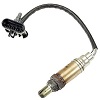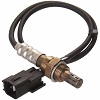
Oxygen sensors have been prevalent in vehicles since the 1970s when Volvo began to use them to measure exhaust gasses for emissions feedback and control. They are considered a wear item and should be replaced roughly every 60,000 to 90,000 miles depending on the make and model or your vehicle, or sooner if you notice any of the common symptoms of a failing sensor.
Function of an Oxygen Sensor
An oxygen sensor is an inline sensor in the engine exhaust system that measures the amount of oxygen remaining in your car’s exhaust gas. This information is fed back to the ECU in order to adjust the amount of fuel delivered to your engine to achieve the appropriate air/fuel ratio given the situation. The oxygen sensor works continuously any time your car is running by sampling the exhaust gas many times per second. Modern cars can have anywhere from one to four oxygen sensors in the exhaust system depending on the vehicle. Cars with multiple oxygen sensors typically monitor groups of cylinders on your engine and help the ECU adjust fuel quantity into each cylinder group independently of the others.
Common Symptoms of a Bad Oxygen Sensor
Check Engine Light – One of the first indicators that an O2 sensor needs to be replaced is that the check engine light comes on. It will turn on when a problem is detected, which is typically a sign that the values the O2 sensor is measuring fall outside of the ECU’s expected range. In the event that your check engine light comes on, it’s best practice diagnose it using an OBD scanner.
Poor Gas Mileage – The oxygen sensor measures the oxygen left in the exhaust gas to maintain the proper fuel input. When the sensor has failed, it will not be able to send proper signals to the ECU. One way the ECU compensates for erroneous O2 sensor signals that read high is by adding fuel. The extra gasoline input will add up over the course of a tank of fuel and lead to reduced gas mileage and more frequent fill-ups. If you have to fuel up more often than normal, it may be time to have the oxygen sensors checked out, especially if you notice it in conjunction with a check engine light.
Rough Engine Idle– The oxygen sensor can affect the idle and cause the engine to run rough, which is particularly noticeable at idle. Prolonged use of a bad O2 sensor can affect other components such as spark plugs due to a rich or lean fuel to air mixture. This can create misfires or issues with incomplete combustion over time which can manifest itself in the form of a rough engine idle or reduced power output.
Replacing an Oxygen Sensor
When it comes to replacing your sensor, the steps are usually pretty simple and straightforward.
Note: The example steps below are intended for general informational purposes solely to help give you an idea of project difficulty and tools required. As all cars are engineered differently, repair procedures and safety hazards vary from vehicle to vehicle. To ensure that you have a vehicle specific repair procedure and an exhaustive list of potential safety hazards, we advise you reference a factory service manual for your vehicle. Similarly, referencing a repair manual such as Chilton or Haynes might serve as a less expensive alternative.
Step 1. Find the location of your sensor(s). As mentioned, you may have one to four of them in your exhaust system. They will most likely thread into a boss on the exhaust manifold or immediately behind the manifold but in front of your catalytic converter. They have an electrical connector and wiring protruding from them. Most often they are accessed from underneath the car. In this case, you will need to raise the car using a floor jack and make sure it is safely supported with jack stands. Alternatively, you could use a ramp and wheel chocks to get your vehicle in the air.
Step 2. Once you have located the sensor, disconnect the wiring connection from the sensor to the harness. There may be a tab on the connector that you need to push before you can separate the connector. Sometimes access to the O2 sensor may be blocked by your airbox that contains your air filter or other components, especially if your O2 sensor is located near the top of the engine. In this event, you may have to remove components that block access to the O2 sensor before proceeding.
Step 3. The Oxygen Sensor will need to be unscrewed from the exhaust manifold. You can use a flare-nut wrench, or a special socket called an O2 sensor socket that fits over the sensor body but allows the wiring to go through an opening in the socket body.
Step 4. If you have purchased a replacement sensor for your vehicle, double check that the connector and number of wires are correct by comparing the new sensor to the original part that you removed. If you purchased a universal sensor that only has wiring, but no electrical connector, you’ll need to take additional steps. We have always found it best to avoid universal sensors for this reason as there isn’t really much cost savings if you go that route but they require more work to install.
Step 5. When the new Oxygen Sensors are ready to be installed back into the boss on the exhaust manifold, first add anti-seize to the threads of the sensor. Often times a small packet of anti-seize is included with a new O2 sensor so you don’t have to buy this separately. Adding anti-seize will prevent the threads from rusting to the exhaust system and make life easier the next time the O2 sensors need to be removed for service. Tighten them into the exhaust per the manufacturers recommended torque and be careful not to over-tighten the sensors. If using an O2 sensor socket, we recommend using a torque wrench for this step.
Step 6. Reconnect the connectors and ensure that they are securely connected to avoid having one come loose while driving (often times you’ll hear an audible click as the tabs on the connector click-in but not always depending on connector type). If you had your car lifted in the air, you can now lower back down to the ground.
Step 7. When the sensor is installed and connected, use an OBD scanner to clear the codes from the ECU which should turn off the Check Engine Light (if it was on). Depending on what codes were thrown, you may have to start and drive the vehicle a few times after clearing the codes before the check engine light goes out.
Best Oxygen Sensor Brands
There are tons of O2 sensor manufacturers out there and the task of selecting the best O2 sensor for your vehicle can require some legwork. In attempt to save you the trouble, we have had great luck over the years with the following brands. The following are the three brands that we typically recommend due to their wide availability and consistently high quality:
Bosch
 Bosch is arguably the original inventor of the oxygen sensor, so it’s likely that their name comes up quite often when discussing oxygen sensors. Bosch offers are variety of vehicle specific and universal oxygen sensors which means that there are lots of options. Unless you have a special project such as an entirely custom engine set up, we suggest just sticking with an OEM version as they are going to be the easiest to swap in to replace your old sensor. Overall, Bosch is probably our favorite manufacturer for O2 sensors and as such we give them a strong recommendation.
Bosch is arguably the original inventor of the oxygen sensor, so it’s likely that their name comes up quite often when discussing oxygen sensors. Bosch offers are variety of vehicle specific and universal oxygen sensors which means that there are lots of options. Unless you have a special project such as an entirely custom engine set up, we suggest just sticking with an OEM version as they are going to be the easiest to swap in to replace your old sensor. Overall, Bosch is probably our favorite manufacturer for O2 sensors and as such we give them a strong recommendation.
Click here to find a Bosch O2 sensor for your vehicle.
Denso
 Denso International is a global auto supplier that specializes in OEM and aftermarket parts for most models of vehicles. They make a variety of ignition and fuel system components, and oxygen sensors make up a decent size portion of their parts portfolio. They have been in the game for quite a while and are known for making long lasting O2 sensors. As such, Denso is one of the top brands for oxygen sensors and we suspect that you won’t be disappointed if you choose to go this route.
Denso International is a global auto supplier that specializes in OEM and aftermarket parts for most models of vehicles. They make a variety of ignition and fuel system components, and oxygen sensors make up a decent size portion of their parts portfolio. They have been in the game for quite a while and are known for making long lasting O2 sensors. As such, Denso is one of the top brands for oxygen sensors and we suspect that you won’t be disappointed if you choose to go this route.
Click here to find a Denso O2 sensor for your vehicle.
Spectra
 Spectra Premium is the newest of the three brands listed but don’t let that fool you! Like the other manufacturers previously mentioned, Spectra is also well known for making high quality O2 sensors for a variety of vehicles. Spectra manufacturers their sensors to high standards to ensure proper function throughout the life of the sensor. Their sensors tend to be well packaged and we are confident that their sensors will treat you well if you decide to purchase one for your vehicle.
Spectra Premium is the newest of the three brands listed but don’t let that fool you! Like the other manufacturers previously mentioned, Spectra is also well known for making high quality O2 sensors for a variety of vehicles. Spectra manufacturers their sensors to high standards to ensure proper function throughout the life of the sensor. Their sensors tend to be well packaged and we are confident that their sensors will treat you well if you decide to purchase one for your vehicle.
